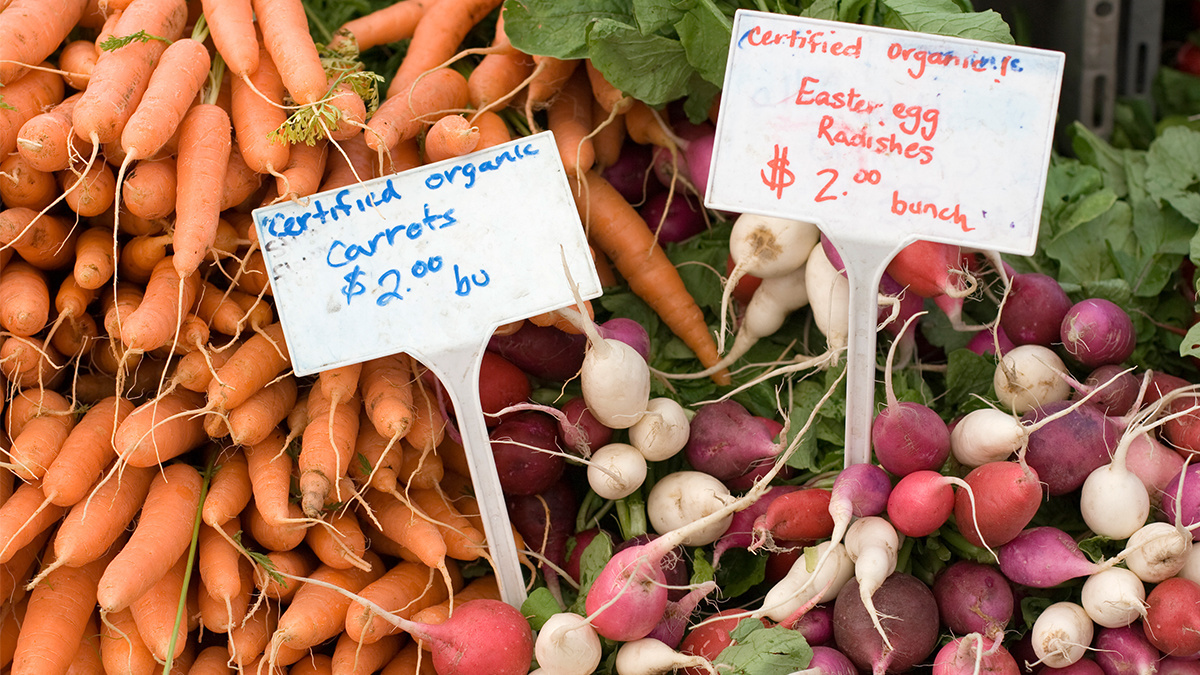

Organic carrots and radishes at a farmers' market. carterdayne / iStock / Getty Images Plus
By Brian Barth
There’s something of a civil war brewing in the organic movement.
On one side are industry boosters boasting about how organic has gone mainstream. These folks are fine with a Big Ag version of organic agriculture — enormous monocrop fields and global distribution to every Walmart across the land. On the other side are purists who feel that the spirit of organic — building healthy soil, promoting biodiversity, focusing on small producers and distributing regionally — is no longer represented by the USDA certified organic label (hence the various alternative organic labels popping up).
The USDA certification has never explicitly required any of those things, however. Instead, organic rules focus primarily on substituting natural fertilizers and pest control methods for chemical ones. But even here things aren’t quite as they seem.
Does Organic Mean Toxin-Free?
Not entirely. USDA standards allow the use of several dozen synthetic chemicals on certified organic farms, although most are fairly benign substances, and those that aren’t tend to be heavily restricted in the ways that they can be applied (certain synthetic fertilizers are also permitted in limited circumstances). More of an issue is that some of the naturally derived substances permitted for use as pesticides are used in unnatural concentrations that make them highly toxic (to creatures such as bees, for example). Rotenone, a notoriously toxic but naturally derived pesticide, was on the list of permitted substances until last year.
Does Organic Mean Local?
Not at all. Organic products constitute around five percent of food sales in the U.S., but only about one percent of U.S. farmland is organic, suggesting that most organic food is imported. Organic certification does not take carbon footprints into account — and it’s fairly clear that organic grapes flown in from Chile have a larger environmental impact than their locally grown but conventional counterparts.
Does Organic Mean Grown on a Small, Diversified Farm?
The organic standards say nothing about size and little about diversity. Things such as hedgerows for habitat are encouraged by the standards, but there is nothing in the rules that prevents organic farmers from planting monocultures fence line to fence line.
Does Organic Mean Livestock Roam Free and Forage on Grass?
This is an extremely contentious topic between Big Organic and the purists. Organic livestock must be provided access to the outdoors and, depending on the species, must receive a portion of their diet from foraging. But there are a lot of convoluted rules — some would call them loopholes— regarding how those requirements can be met. The bottom line is that it’s possible to stick to the letter of the organic law and run a livestock operation that differs little from a confined animal feeding operation, aka factory farming.
Does Organic Mean Topsoil is Restored?
Rebuilding topsoil that teems with microbial life was the foundation of the organic movement in the 1960s. This was a response to the sterile, eroded soil that 20th-century conventional agriculture methods left across the planet. The inconvenient truth is that organic agriculture requires frequent cultivation to control weeds, leaving it bare and susceptible to erosion. In the 21st century, conventional agriculture is increasingly based on the use of herbicide-tolerant GMO crops that have vastly reduced the amount of tillage required, cutting down significantly on erosion (at the cost of greater herbicide use, however). Erosion as a result of frequent cultivation isn’t much of an issue on a small diversified farm, but large monocultures of organic produce are likely to lose more topsoil each year than well-managed conventional ones.
Reposted with permission from our media associate Modern Farmer.

 233k
233k  41k
41k  Subscribe
Subscribe 